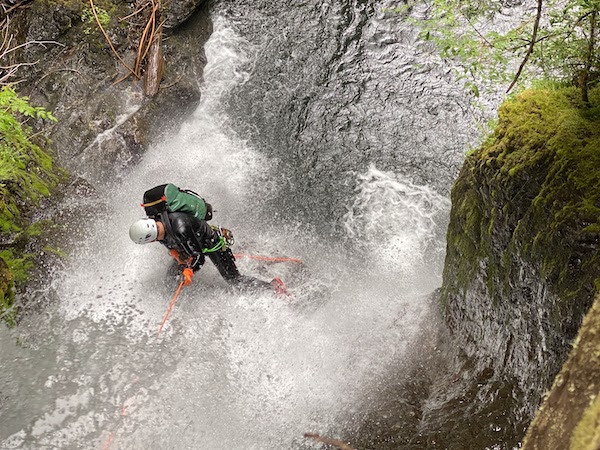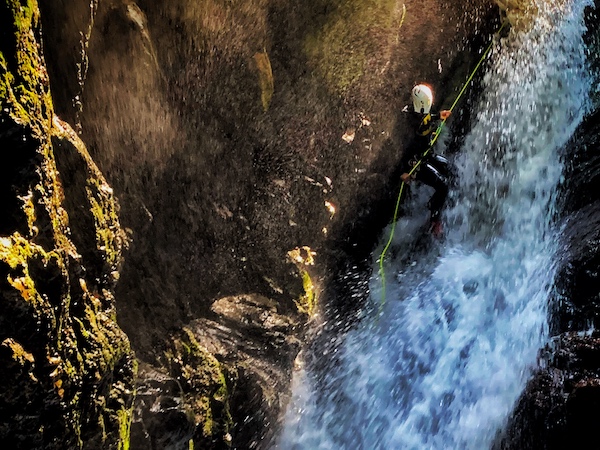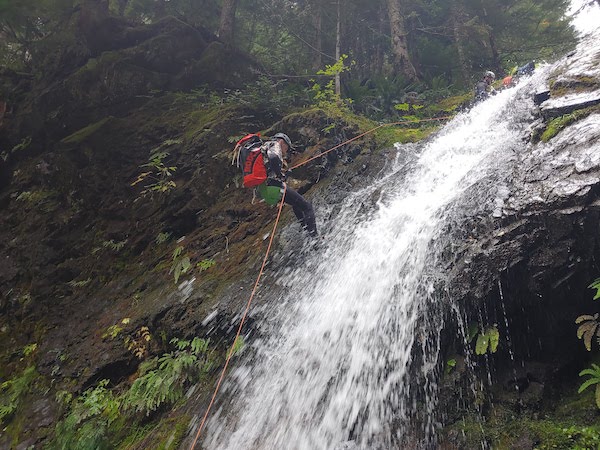Canyoning Washington: Skills and Descents Overview The American Alpine Institute's Washington Canyoning: Skills and Descents program was designed for those who are interested in entry to intermediate level instructional guided descents in the Pacific Northwest.
AAI offers two introductory canyoning courses in Washington:
Canyoning (also known as Canyoneering) is the technical practice of exploring the deep grooves carved by water over the eons. Swiftwater Canyoning is the art of doing this when there is water actively moving in this terrain. This requires an expert level of knowledge in several technical fields.
The Pacific Northwest has become known as a world-class place to develop swiftwater canyoning skills. People come from all over the globe to explore the wild and wet canyons of the Pacific Northwest. And this is why AAI's swiftwater programs are based in the Olympics and Cascades of Washington State.
AAI's Washington Canyoning: Skills and Descent program was designed for those who have basic rappelling skills and wish to recieve instruction and guidance in a swiftwater canyon environment. AAI also offers a more comprehensive six-day course, Introduction to Swiftwater Canyoning , for those who desire a "deeper dive."
VIDEO
Canyoning Washington: Skills and Descents Canyon Options The location of the guided descents for this program will be based on the current canyon conditions. The amount of water in a given canyon can have a tremendous impact on both the canyoneer's experience and the amount of hazard.
Following are common options based on the time of the year. It should be noted, that a program location may change at the last minute if conditions are too hazardous for the descent. The guide will make a determination before the start of program.
Olympic Program (June-July)
Rock Creek (3C II)
A combination of mostly short rappels interspersed with a few optional jumps make this short canyon an excellent place for people to dial in their baseline canyon skills. This canyon is a pleasant and laid back adventure.
LeBar Canyon (3C III)
This is another short beginner canyon with five rappels and a lot of mandatory swimming. This is an exceptionally scenic canyon that is mostly just out of sight of from the local trails and campsites. The amount of required swimming makes this a great objective for a hot day.
Fir Creek (3C1 I)
This objective requires five rappels and a jump. Though not a particularly long canyon, there are some cool pothole features. And if you're moving, you may be able to link this with one of the preceding canyons.
Randle Program (July-September)
Davis Creek Canyon (3C2 II)
This is considered to be one of the most beautiful canyons in the state. It is deeply entrenched and includes up to ten rappels and three jumps. With a quick approach and exit -- no more than five minutes -- this is an incredibly accessible technical canyon.
Hager Canyon (3C III)
Also known as "Sick Pupppy Canyon," this is a heck-of-an-adventure, with a lot of technical challenges and hazards that must be mitigated. The canyon requires seven rappels and nine slides. At least one descripton refers to this thing as a waterpark. That said, it is an advanced canyon for those who do well on the first day of their program.
Big Canyon (3C2 III)
Somewhat south of the preceding canyons in the area, this objective is located directly between Mt. Adams and Mt. St. Helens. This canyon starts with a massive overhang that drops you down into a beautiful basalt amphitheater. With eight rappels, one jump and some complicated transitions, this canyon provides some interesting technical challenges in a very cool setting.
Snoqualmie Program (August-September)
Change Creek (3C II)
This is an exceptional beginner canyon that terminates right next to the highly popular climbing area, Exit 38. The approach for this eight rappel adventure is short (no more than 60-minutes) with a tremendous amount of payoff. This is commonly done on the first day of a program.
Denny Creek Canyon (3B III)
This is another entry-level canyon and, depending on how you do on the first day, this may be an option for the second. It is similar to Change Creek with approximately eight rappels, but depending on water flow there can be a slide.
Dingford Creek (3C III)
Dingford is considered to be one of the best canyons in the Snoqualmie area. This objective has it all. A descent requires up to two jumps, four slides and up to thirteen rappels. With features with imposing names like the "Dragonchute" and "Chunderdome," this is a canyon that is not to be missed...
Canyoning Washington: Skills and Descents Dates and Details Program Dates:
June 22 - June 23, 2024 (Entry-Level)
July 24 - July 25, 2024 (Advanced)
Aug 24 - Aug 25, 2024 (Entry-Level)
Group Pricing for Two-Day Canyon Pre-Scheduled Programs:
$525 per canyoneer (Minimum of 3 Participants)
Capacity: Up to 10 Participants Per Program (Commonly 4-6)
Private Pricing for Two-Day Canyon Tour:
$995 - 1 Participant
$850 each - 2 Participants
$600 each - 3 Participants
$550 each - 4 or More Participants
Cost Inclusions and Exclusions
Inclusions: Permits and guide fees. Group technical canyoning equipment is also included.
Exclusions: Items not included in the course fee include personal clothing, camping gear, meals while on program, and travel insurance. Personal canyoning gear is not provided. Some equipment may be rented from AAI's Equipment Shop. Inquire for details.



